
|
Two Standard Zoom Lenses for Four Thirds Cameras 14-45 mm versus 14-54 mm Zuiko Digital |

|
My other articles related to the |
|
Note of 2008: as of this update, the 14-45 mm ZD is no longer made, having been replaced with the compact 14-42 mm ZD (see the list below). The 14-54 mm ZD is, however, still in production, still remaining one of the more desirable Four Thirds lenses, even if facing a stiff competition from the 12-60 mm ZD (a great lens, but twice the price!). |
|
Traditionally, a "standard" lens for a given frame format is one with the focal length equal to (or slightly larger than) the diagonal of the frame. In case of the 35-mm film, that diagonal is 43 mm, and F=50 mm is traditionally recognized as "standard"; for the Four Thirds system the corresponding focal length (providing the same angle of view) is half of that, i.e., 25 mm. This focal length results in the perspective being most natural, especially when the final picture (print or screen image) is viewed from a distance close to the diagonal of the final size. This also means that this is the focal length most useful for most, if not all, shooting situations. Predominance of zoom lenses changed the situation a bit. Photographers are becoming too lazy to walk closer to (or away from) the subject to get the proper framing; they often tend just to zoom in or out, and this is not the same. Worse, many users stay mostly at or near to one or the other end of the zoom lens focal length range, neglecting the useful middle. Anyway, zoom lenses are here to stay, at least for the most general uses. Those with a focal length range centered around the "standard" value are often referred to as "standard" zooms. In terms of the EFL (equivalent focal length), a standard zoom will have a range from 28 or 35 mm to 70, 100, or even 140 mm. Extending this range from either end, although possible, comes at a price of smaller apertures, lower optical quality (resolution, vignetting, distortions), or both. This article compares directly two "standard" zoom lenses from the Olympus Four Thirds line-up:
| ||||||||||||||||||||||||||||||||||||||||||||||||||||||||||||||||||||||||||
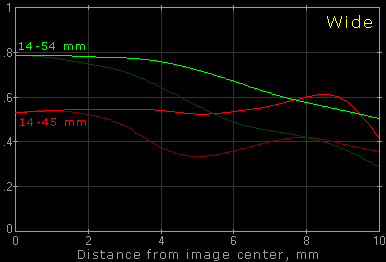
|
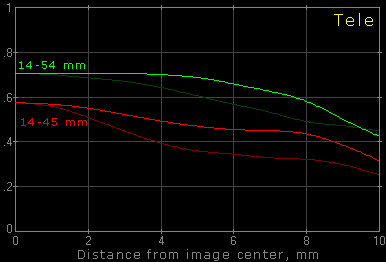
| |
| Modulation Transform Function (MTF) curves for the ZD 14-45/3.5-5.6 (red) and ZD 14-54/2.8-3.5 (green) zoom lenses, set to the shortest (left graph) and longest (right graph) focal lengths, with maximum (wide open) aperture. The pattern frequency was 30LP/mm, or 60 LW/mm (equivalent to 15/LP mm on the 35-mm film frame). MTF lines for both sagital and tangential patterns are shown in brighter and dimmer colors, respectively. | ||
|
I am not going here into a detailed discussion of the MTF used to represent lens sharpness; have a look at my general introduction to the subject. It is enough to state that our graphs at 30 cycles/mm show higher contrast for the 14-54 mm lens, which is an indication of higher resolution (better "sharpness"). This holds at both ends of the focal length range, and that in spite of the fact that the 14-54 mm lens has a wider maximum aperture. While the MTF graphs clearly show the difference, they do not allow us to say how visible this difference is when you are looking at actual images of real-life subjects. Here is where I dump the whole MTF thing and start taking pictures, to see things with my own eyes.
|
|
| |
| 14-45 mm at 14 mm | |
|
| |
| 14-54 mm at 14 mm |
|
Clearly, the economy lens exhibits some amount of barrel distortion at the widest-angle setting. I haven't measured this, but my guess would be a tad more than 1%, quite acceptable. The mid-priced lens gets rid of that effect — almost entirely. You can still see some (use an edge of a sheet of paper against your screen as a reference), but nothing worth mentioning. This is as good as I have seen in any 28 mm EFL lens. Distortion often depends also on focusing distance. My impression is that it is more visible in both lenses at distances of less than one meter or so, with the 14-54 mm, again, clearly showing less of the effect. Close-focus capability I was able to verify the manufacturer's claims regarding close-focusing capabilities of both lenses, by changing the subject-to-camera distance until no AF was any longer possible.
| |||||||||||
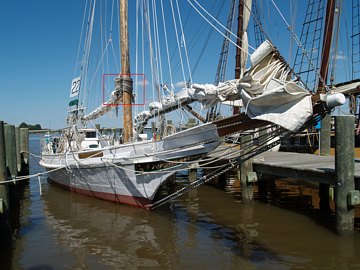
|
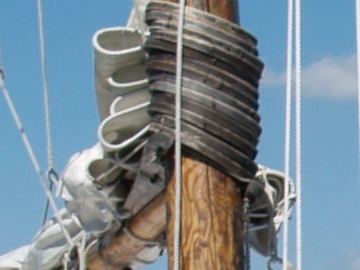
| |
| E-500, Lens A; program exposure (-0.3 EV): 1/200 s at F/9, ISO 100, WB at 5300K, Natural picture mode; contrast at -1, sharpness at -2, saturation at 0. The full frame can be found here. | ||
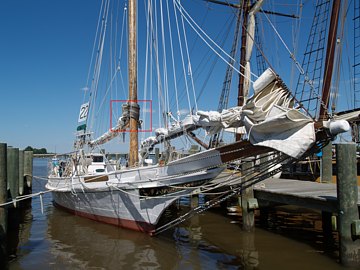
|
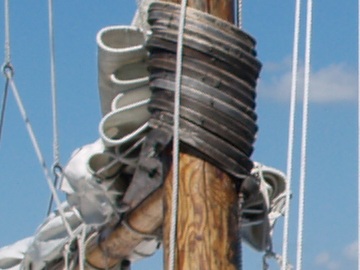
| |
| E-500, Lens B; program exposure (-0.3 EV): 1/320s at F/8, ISO 100, WB at 5300K; other settings as above. Here is the full frame. | ||
|
True, under sunny conditions the aperture was stopped down quite a bit, and this is where most lenses will perform respectably. Still, even at wider apertures I experienced problems with this exercise. The pictures were taken at the wide end of the zoom, so there was plenty of depth of field available, and the focus was set at the full-size sample area. Nota also that my in-camera sharpening is set way down; I believe that it is more proper to do sharpening at the post-processing stage. OK, here it is: Lens A (top) is the 14-45 mm, "economy" zoom, lens B (bottom) — the 14-54, mid-priced one. (The economy lens was set to 16 mm to provide a similar frame; with no tripod I might have moved a bit when changing lenses.) Clearly, a couple of casual shots is not enough to see any differences in lens quality, as long as both lenses are "good enough", which seems to be the case. Small differences in AF accuracy, for example, may affect images to a greater degree. Therefore here is a series of comparative samples shot under more controlled conditions. A medium-weight tripod was used to provide exactly the same standpoint and greater camera stability, and this series was shot at the maximum aperture (smallest F-number), which puts the "economy" lens at some advantage; fine with me. Most importantly, the series below was shot with the camera in the Manual Focus mode, autofocusing done by pressing the Lock button, and with a five-frame focus bracketing, to select the sharpest image out of the series. (As it turned out, in each case the first frame, as set by the AF system, was the best, so the precaution was not really needed. This just confirms that the system works fine.) All these images were shot in the Vivid picture mode, with sharpness adjusted to -1; white balance manually set to Sunny (5300K). Images were saved as JPEG SHQ files (compression of 1:2.7). First, the samples at the widest focal length of 14 mm (28 mm EFL): | ||
.r.jpg)
|
.f.jpg)
| |||||||||
| E-500, 14-45 mm ZD at 14 mm, aperture priority (-0.3 EV): 1/1250 s at F/3.5; ISO 100. | ||||||||||
.r.jpg)
|
.f.jpg)
| |||||||||
| E-500, 14-54 mm ZD at 14 mm, aperture priority (-0.3 EV): 1/2000 s at F/2.8; ISO 100. | ||||||||||
|
As we can see, the mid-priced lens seems to be just a tad sharper; this was confirmed by my wife and myself scrutinizing the full-size samples blind, i.e., not knowing which is which. The difference, though, is really small. Next, samples for the "normal" focal length of 25 mm (50 mm EFL): | ||||||||||
.r.jpg)
|
.f.jpg)
| |||||||||
| E-500, 14-45 mm ZD at 25 mm, aperture priority (-0.3 EV): 1/800 s at F/4.2; ISO 100. | ||||||||||
.r.jpg)
|
.f.jpg)
| |||||||||
| E-500, 14-54 mm ZD at 25 mm, aperture priority (-0.3 EV): 1/1250 s at F/3.1; ISO 100. | ||||||||||
|
Here the difference in favor of the 14-54 mm lens, although still small, is a bit more visible. Lastly, a comparison at the telephoto end, which is 45 mm (EFL of 90 mm) for the economy lens, and 20% longer, or 54 mm (EFL 108 mm) for the mid-priced one: | ||||||||||
.r.jpg)
|
.f.jpg)
| |||||||||
| E-500, 14-45 mm ZD at 45 mm, aperture priority (-0.3 EV): 1/200 s at F/5.6; ISO 100. | ||||||||||
.r.jpg)
|
.f.jpg)
| |||||||||
| E-500, 14-54 mm ZD at 54 mm, aperture priority (-0.3 EV): 1/500 s at F/3.5; ISO 100. | ||||||||||
|
The comparison is not as straightforward for these samples because of the 20% difference in focal length, working in favor of the mid-priced lens. Still, the latter appears to have a slight edge here, if only by a small margin. Keep in mind, though, that the shooting aperture is by 4/3 EV larger for that lens. To be frank, I should have applied a -0.7 compensation here, to extract the weathered wood texture better. Never trust the camera's automation; as a human you are supposed to be smarter! This adjustment is applied in the next sample: | ||||||||||
.r.jpg)
|
.f.jpg)
| |||||||||
| E-500, 14-45 mm ZD at 14 mm, aperture priority (-0.3 EV): 1/320 s at F/8; ISO 100. | ||||||||||
.r.jpg)
|
.f.jpg)
| |||||||||
| E-500, 14-54 mm ZD at 54 mm, aperture priority (-0.3 EV): 1/320 s at F/8; ISO 100. | ||||||||||
|
The slight edge the mid-priced lens has here is not a surprise. Have a look at the bottom of the shack, though: clearly, it is curving out in the first sample. This shows the effect discussed above in the Distortion section. One more comparison, this time shot without focus bracketing, but with a tripod; lens at F/8, widest angle. The focus was set at the wooden stairs. | ||||||||||
.r.jpg)
|
.f.jpg)
| |||||||||
| E-500, 14-45 mm ZD at 14 mm, aperture priority (-0.3 EV): 1/320 s at F/8; ISO 100. | ||||||||||
.r.jpg)
|
.f.jpg)
| |||||||||
| E-500, 14-54 mm ZD at 14 mm, aperture priority (-0.3 EV): 1/320 s at F/8; ISO 100. | ||||||||||
|
Surprisingly, even when both lenses are stepped down to F/8, the mid-priced one has an advantage, as slight as it may be. I expected to see no differences at this aperture. In addition, the image shot with the 14-45 mm lens seems to have a slightly cooler tonality. I would rather attribute that to a small cloud momentarily obstructing the sunlight (the shots were taken 37 seconds apart), as other pictures of the wooden boardwalk series, and I shot 16 of those, do not show a similar effect. I'm afraid you may be sick and tired of looking at image samples; so am I. To recap my impressions regarding lens resolution:
| ||||||||||

|
My other articles related to the |
|
Olympus® is a registered trademark of Olympus Corporation.
This page is not sponsored or endorsed by Olympus (or anyone else) and presents solely the views of the author. |
| Home: wrotniak.net | Search this site | Change font size |
| Posted 2006/07/01; last updated 2008/06/28 | Copyright © 2006-2008 by J. Andrzej Wrotniak |